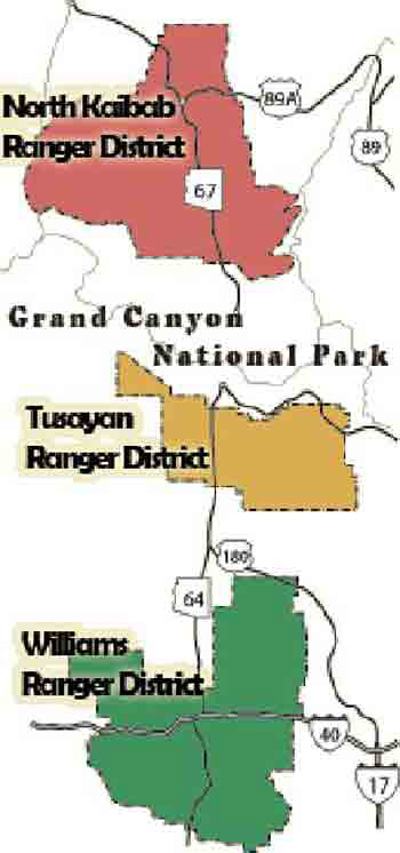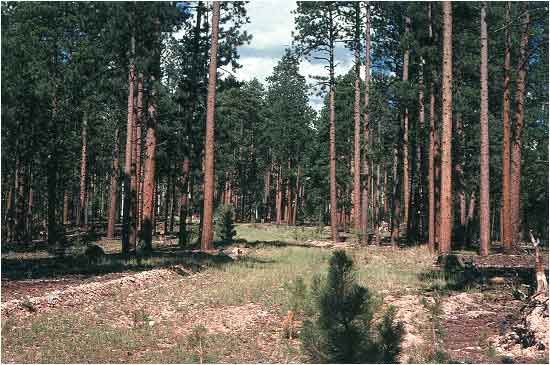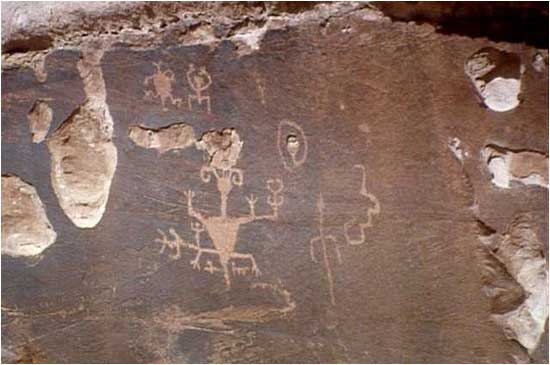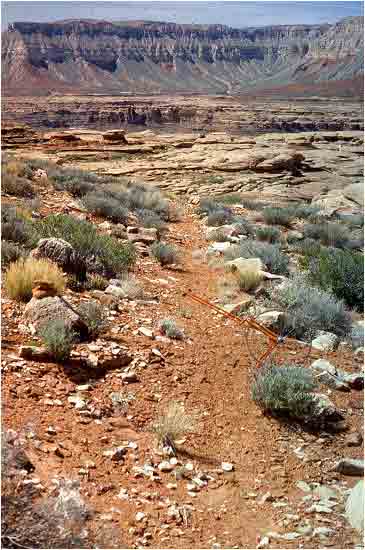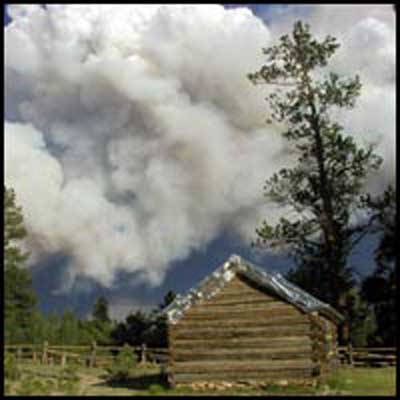Kaibab National Forest can be considered the gateway to the Grand Canyon in two different senses. First, much of the land that comprises Grand Canyon National Park was created out of the original Kaibab National Forest in 1919. Second, visitors approaching the Grand Canyon from any of the major roads to the North and South Rim must pass through sections of Kaibab National Forest. However, the relationship between the Forest Service and the National Park Service has not always been friendly or complementary.
Kaibab National Forest, composed of the Williams, Tusayan, and North Kaibab Ranger Districts, is one of six National Forests in Arizona. The word “kaibab” is derived from a Paiute term meaning “mountain lying down,” their name for the Grand Canyon. The modern North Kaibab district was once part of the Grand Canyon Forest Reserve established in 1893. In 1906, President Theodore Roosevelt designated over 600,000 acres of the Grand Canyon Forest Reserve as a Game Preserve. Those lands are now part of Kaibab National Forest. In fact, according to the Forest Service website, today the Kaibab is the only forest in the National Forest system that is designated as a Game Preserve.
In 1908, Roosevelt created Grand Canyon National Monument, which eleven years later became Grand Canyon National Park, administered by the new National Park Service. The remaining forest reserve and game preserve lands north of the Grand Canyon were renamed Kaibab National Forest. However, because the National Park Service only maintained a small force of rangers on the North Rim, for the first several years after the park was created, the Forest Service often provided extra rangers to help maintain services and protect resources.
In 1925, Grand Canyon National Park waged a fight to expand its boundaries, which were basically limited to the canyon and a thin strip along the rim. The NPS argued that this limited area did not allow it to protect biotic resources on a sufficient scale and did not allow enough visitors to fully enjoy the park area. Administrators put forth several different proposals for expanding park boundaries, most of which involved taking over portions of Kaibab National Forest land. Many of America’s national parks were carved out of national forests because the federal government already owned the lands so it merely needed to transfer management from one agency to another. National forests were dedicated to a “multiple-use” policy that allowed logging, grazing, mining, hunting, and hydropower development. National parks were dedicated to preservation and public recreation. Not surprisingly, every effort to create national parks out of national forests generated controversy. The Forest Service did not want to relinquish its lands to the Park Service, and the timber, grazing, and mining interests did not want to lose opportunities to use the resources on these public lands.
At Grand Canyon, the Forest Service eventually gave up some land while keeping the right to build more roads into their holdings on the South Rim, and agreed to limit logging along their border with the park. Therefore, in 1927 Congress authorized the transfer of 45,000 acres of national forest land on the North Rim and 2,000 acres on the South Rim to Grand Canyon National Park. This allowed the Park to develop more tourist facilities, and include a representative tract of ponderosa pine and mixed conifer forest in Grand Canyon National Park. Though the Forest Service and National Park Service today enjoy a relatively friendly relationship, their distinct missions continue to generate tension, especially on the park/forest borders where the two agencies’ land management activities sometimes come into conflict.
In 1934, the separate Tusayan National Forest south of the Grand Canyon was merged with the Kaibab National Forest to form the current forest boundaries. The Kaibab Forest’s headquarters are located south of the Grand Canyon in Williams, Arizona. The forest contains one of only two National Scenic Byways in the Southwestern region (Arizona and New Mexico): the Kaibab Plateau-North Rim Parkway, a 44-mile scenic drive.
The 1.6 million-acre Kaibab National Forest encompasses part of the largest contiguous ponderosa pine forest in the United States. It extends from both the north and south rims of the Grand Canyon. Elevations range from 5,500 to nearly 10,500 feet and include a variety of trees, including ponderosa pine, Douglas fir, aspen, blue spruce, oak, pinyon pine, and juniper. Wildlife includes elk, mule deer, antelope, turkey, coyote, mountain lion, black bear, bobcat, Abert’s squirrels, and a variety of hummingbirds, woodpeckers, and other birds. In National Forests natural resources may be harvested—although the Forest Service is supposed to assure that it is done sustainably.
The Forest contains archeological resources that attest to the long history of human occupation in the Grand Canyon region. These sites are mostly associated with the Cohonina, who lived in the area between 700 and 1100 AD, and include stone houses, potsherds, stone tools, and rock art. It also contains cultural resources that speak to the more modern Euro-American occupation of the landscape, such as logging railroads and historic fire watchtowers. To date, over 6,000 archeological and historic sites have been recorded in the forest, and several have been nominated to be placed on the National Register of Historic Places. The Forest Service is currently reconstructing a 1,000-year-old Cohonina ruin in Williams at the Ranger Station.
Popular activities include hiking, trail rides, mountain biking, cross-country skiing, and wildlife viewing. Approximately 150,000 visitors a year camp at the four developed Forest Service campgrounds. There are about 25 trails in the Forest for all skill levels.
The Kaibab National Forest is owned by the American people. The supervisor of the Forest must seek public input on development and management decisions and write environmental impact statements when proposing actions that would significantly affect the environment. These are your lands. Get on the forest’s mailing list and provide input to the professionals who administer these lands in trust for you!
One issue that confronts both Kaibab National Forest and Grand Canyon National Park is that of fires. While forest fires were once considered unacceptable and were vigorously suppressed, scientists over the course of the twentieth century came to realize that they are essential to maintaining healthy forests. Fires burn out undergrowth and return nutrients to the soil, they help certain plants such as perennial grasses to thrive, and help other plants such as lodgepole pine to reproduce. The rainy season in summer brings violent thunderstorms to the area, making lightning strikes a dangerous source of forest fires. An average of 100 fires occur in the forest every year, with 25% of these caused by humans.
There is a delicate balance between allowing fires to burn in order to rejuvenate natural resources and protecting local property and viewscapes. For example, in the summer of 2006 lightning started a blaze named the “Warm Fire,” which the Forest Service monitored and lightly managed for two and a half weeks while it burned approximately 19,000 acres. However, it then grew beyond the boundaries deemed acceptable by the agency, and the Forest Service changed to a suppression strategy. At that point the fire burned destructively hot for nine more days consuming 39,100 more acres before the Forest Service could contain it. Rehabilitation efforts began immediately and continue to the present.
Kaibab National Forest celebrated its 100th anniversary in 2008.
Written By Sarah Bohl Gerke and Paul Hirt
References:
- Anderson, Michael F. Living at the Edge: Explorers, Exploiters and Settlers of the Grand Canyon Region. Grand Canyon Association, 1998.
- Anderson, Michael F. Polishing the Jewel: An Administrative History of Grand Canyon National Park. GCA, 2000.
- Kaibab National Forest website: www.fs.fed.us/r3/kai/
- Morehouse, Barbara J. A Place Called Grand Canyon: Contested Geographies. Tucson: University of Arizona Press, 1996

